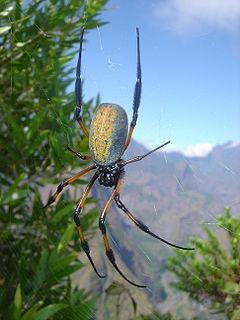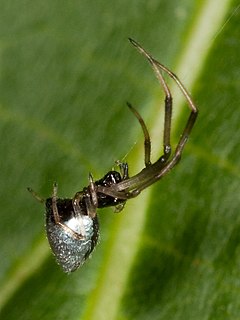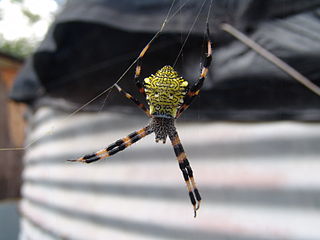
Nephila is a genus of araneomorph spiders noted for the impressive webs they weave. Nephila consists of numerous species found in warmer regions around the world. They are commonly called golden silk orb-weavers, golden orb-weavers, giant wood spiders, or banana spiders.

Trichonephila inaurata,, commonly known as the red-legged golden orb-weaver spider or red-legged nephila, is a species of orb-weaver spider of the genus Trichonephila. It is native to southern and East Africa, as well as several islands of the western Indian Ocean.

Pterinochilus murinus is an old-world tarantula that was first described in 1897 by Reginald Innes Pocock. This species is found on the African continent, in Angola, as well as central, eastern, and southern Africa. It is a member of the subfamily Harpactirinae, baboon spiders.

Argyrodes, also called dewdrop spiders, is a genus of comb-footed spiders that was first described by Eugène Louis Simon in 1864. They occur worldwide, and are best known for their kleptoparasitism. They can spin their own webs, but tend to invade and reside in their hosts' webs. This relationship can be commensal or even mutual if the dewdrop spider feeds on small trapped insects that are not eaten by the host. Some species can even prey upon the host.

Argiope appensa is an orb-weaving spider belonging to the family Araneidae.
Argyrodes argentatus is a kleptoparasitic spider.

The anatomy of spiders includes many characteristics shared with other arachnids. These characteristics include bodies divided into two tagmata, eight jointed legs, no wings or antennae, the presence of chelicerae and pedipalps, simple eyes, and an exoskeleton, which is periodically shed.

Argiope argentata, commonly known as the silver argiope due to the silvery color of its cephalothorax, is a member of the orb-weaver spider family Araneidae. This species resides in arid and warm environments in South America, Central America, Southern California, Florida, Arizona, Texas, and the Caribbean. A. argentata create stabilimenta and a unique zig-zag in its web design, and it utilizes its UV-reflecting silk to attract pollinating species to prey upon. Like other species of Argiope, its venom is not harmful to humans; however, it can be employed to immobilize its prey. A. argentata engages in sexual cannibalism either mid- or post-copulation. One aspect of particular interest regarding this species is its extinction patterns, which notably have minimal correlation with its population size but rather occur sporadically for the species.

Metepeira labyrinthea, the labyrinth orbweaver, is an American dollar coin-sized spider, with thin legs and a round, bulbous abdomen It is a member of the genus Metepeira in the family Araneidae. The female’s length is 5.3 mm, its carapace 2.3 mm, abdomen 3.3 mm, and extended legs 18.4 mm. The carapace is brown or gray, and the abdomen is dark with a white pattern. The legs alternate pale brown and dark brown, and the sternum is dark brown with a longitudinal yellow mark. The male spider is three-quarters of the female’s length, or slightly larger, with a darker carapace and with greater contrast between dark and light areas of the legs. Metepeira are easily distinguished from other Araneidae by their light eye region, white median line on the sternum, relative length of the leg segments, small male palpus, weakly sclerotized epigyne and the special composite web.

Argiope pulchella is a species of the orb-weaver spider family, Araneidae. It ranges from India to China and can be found on Java. It is a synanthropic species, often living in habitats associated with humans.

Cyrtophora exanthematica are tent spiders common in tropical Asia and Australia. They are commonly known as double-tailed tent spiders because of the pair of blunt projections at the end of their abdomens. They are harmless to humans.
A. flavescens may refer to:
Argyrodes chionus is a species of tangle-web spider that is endemic to Aldabra in the Seychelles. It is found in dry shrubland at sea level. It is threatened by habitat deterioration due to sea level rise.
Argyrodes cognatus is a species of tangle-web spider that is endemic to the Seychelles, and can be found on Mahé, Conception, Silhouette and Marianne islands. It is found in woodland habitats where it spins orb webs in herbaceous vegetation. It is threatened by habitat deterioration due to invasive plants, especially Cinnamomum verum.
Argyrodes fissifrontellus is a species of tangle-web spider that is endemic to the Seychelles, and can be found on Mahé and Silhouette islands. It is found in woodland areas where it spins orb webs in vegetation, or is a keptoparasite in red-legged golden orb-web spider webs. It is threatened by habitat deterioration due to invasive plants, especially Cinnamomum verum.
Argyrodes rostratus is a species of tangle-web spider that is endemic to the Seychelles, and can be found on Mahé, Île Sèche, Cerf, Conception, Silhouette, Curieuse, Cousin, Aride, Praslin, La Digue, Grand Sœur, Felicite, Marianne, Denis islands and the Alphonse and St. François atolls. It is found in woodland, shrubby habitat and gardens, and is a kleptoparasite of red-legged golden orb-web spiders. It is threatened by habitat deterioration due to invasive plants, especially Cinnamomum verum.
Argyrodes fissifrons, the split-faced silver spider, is a species of spider of the genus Argyrodes. It is found in Sri Lanka to China and Australia.

Argyrodes elevatus, commonly referred to as dew-drop spider, is part of the family Theridiidae that consists of more than 3,000 species. These spiders are most commonly found in subtropical and tropical regions in South and Central America, as well as southern regions of the United States. One of the key distinguishing characteristics of A. elevatus is its kleptoparasitic behavior through which it primarily procures food for survival. Typically 1 or 2 A. elevatus spiders preside in outer areas of webs built by other species of spiders, although it is possible for up to 45 spiders. There are two main mechanisms by which A. elevatus raid the hub of the host’s web to steal insects preyed and wrapped by the host spider. A. elevatus follows an intricate course to the hub of the web to search for prey, using vibrational detection enhanced by laid out threads along the web to find and capture the insect. These spiders are highly efficient, with the theft lasting a maximum of 12 seconds and high success rates. This reliance on a host spider for food has led to adaptations in sleep schedules and alternate food sources to revolve around the host species activity. A. elevatus display a unique courtship routine in which male A. elevatus presents prey wrapped in silk as a nuptial gift to the female spider. The male spider approaches the female, carrying the nuptial gift on its chelicerae while communicating with a distinct courting vibration, followed by copulation. Approximately twenty-four hours after the A. elevatus courtship and copulation series of events, the female spider will lay one to two eggs on the outer regions of the host's web.

Argyrodes antipodianus, also known as the dew drop spider, is a species of kleptoparasitic spider from the cobweb spider family found in Australia, New Zealand and New Caledonia.













